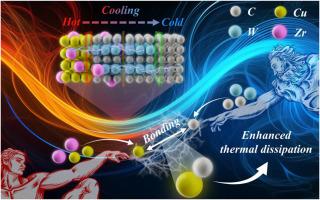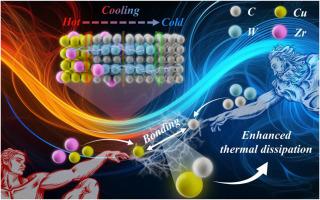Simultaneously enhancing heat transfer ability, thermal expansion matching and thermal stability of diamond-reinforced Cu matrix composites through multi-level interface layer design
IF 9.7
2区 材料科学
Q1 MATERIALS SCIENCE, MULTIDISCIPLINARY
引用次数: 0
Abstract
Although diamond-reinforced Cu matrix (diamond/Cu) composites can achieve high thermal conductivity (TC) via interface modification, the significant mismatch in the coefficient of thermal expansion (CTE) between these composites and semiconductors, along with the degradation of heat transfer performance during long-term service, severely impedes their engineering applications. In this work, inspired by the concept of elemental interdiffusion, a novel interface design strategy combined with the control of the interface layer thickness was put forward to achieve the goal of simultaneously enhancing the heat transfer ability, thermal expansion matching, and thermal stability of the diamond/Cu composites. The results reveal that, when adjusting the sputtering time to 45 min, the designed diamond/Cu composites exhibit an excellent TC of 743 W∙m−1∙K−1, a low CTE of 4.5 × 10−6 K−1 at 323K and a faster thermal response. After undergoing 100 thermal cycles in an atmospheric environment, the composites maintain a high thermal diffusion coefficient up to 244.9 mm2∙s−1, with only a 20.7 % decrease. It has been confirmed that introducing the WC-(Zr,W)C multi-level interface layer is conducive to improving the interfacial bonding strength and phonon matching between diamond and matrix. In addition, there are uniformly distributed diamond particles, a high relative density, and isolated pores in the diamond/Cu composites post-thermal shock, ensuring the distinguished heat transfer ability. This work not only tackles the engineering application challenges of diamond/Cu composites and elucidates in-depth understanding of the enhancement mechanisms, but also offers a fresh perspective for interface layer design in thermal management composites.


通过多级界面层设计,提高了金刚石增强铜基复合材料的传热能力、热膨胀匹配性和热稳定性
虽然金刚石增强Cu基(金刚石/Cu)复合材料可以通过界面改性获得高导热系数(TC),但这些复合材料与半导体之间的热膨胀系数(CTE)显著不匹配,以及长期使用过程中传热性能的下降,严重阻碍了它们的工程应用。在元素相互扩散概念的启发下,提出了一种结合界面层厚度控制的界面设计策略,以达到同时增强金刚石/Cu复合材料的传热能力、热膨胀匹配性和热稳定性的目的。结果表明,当溅射时间调整为45 min时,设计的金刚石/Cu复合材料的TC为743 W∙m-1∙K-1,在323K时CTE较低,为4.5 × 10-6∙K-1,热响应更快。在大气环境中经过100次热循环后,复合材料保持了较高的热扩散系数,达到244.9 mm2·s-1,仅下降了20.7%。研究证实,引入WC-(Zr,W)C多级界面层有利于提高金刚石与基体之间的界面结合强度和声子匹配。此外,热冲击后金刚石/Cu复合材料中金刚石颗粒分布均匀,相对密度高,孔隙隔离,保证了优异的传热能力。这项工作不仅解决了金刚石/Cu复合材料的工程应用挑战,阐明了对增强机制的深入理解,而且为热管理复合材料的界面层设计提供了新的视角。
本文章由计算机程序翻译,如有差异,请以英文原文为准。
求助全文
约1分钟内获得全文
求助全文
来源期刊

Materials Today Physics
Materials Science-General Materials Science
CiteScore
14.00
自引率
7.80%
发文量
284
审稿时长
15 days
期刊介绍:
Materials Today Physics is a multi-disciplinary journal focused on the physics of materials, encompassing both the physical properties and materials synthesis. Operating at the interface of physics and materials science, this journal covers one of the largest and most dynamic fields within physical science. The forefront research in materials physics is driving advancements in new materials, uncovering new physics, and fostering novel applications at an unprecedented pace.
 求助内容:
求助内容: 应助结果提醒方式:
应助结果提醒方式:


